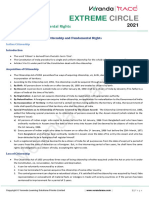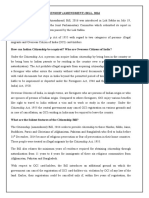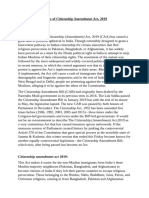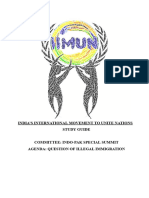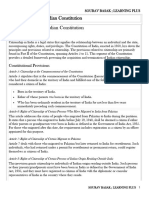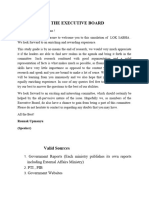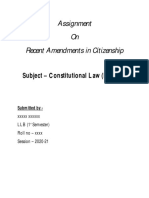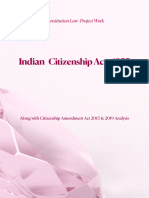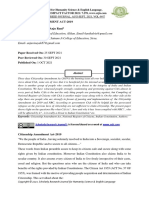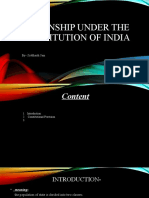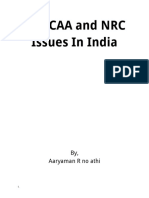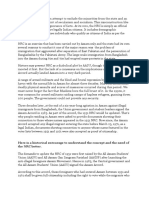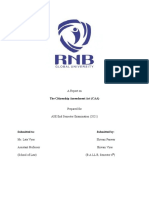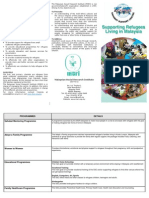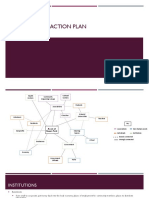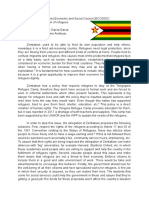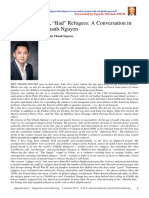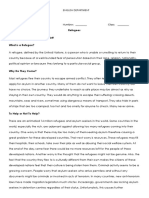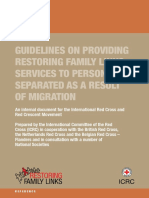0 ratings0% found this document useful (0 votes)
41 viewsPolity & Governance: 1.1. Citizenship Amendment Act
Polity & Governance: 1.1. Citizenship Amendment Act
Uploaded by
Moryz PandeyThe document discusses the Citizenship Amendment Act (CAA) which provides a path to citizenship for religious minorities fleeing persecution from Afghanistan, Pakistan and Bangladesh who entered India on or before December 31, 2014. It links the CAA to the National Register of Citizens (NRC) which could identify illegal migrants. While supporters argue it protects religious minorities, critics say it discriminates by excluding Muslims and ignoring persecution of other communities. It may also violate the Assam Accord and India's secular constitution. Implementing the CAA along with a nationwide NRC risks leaving many long-term residents of India stateless.
Copyright:
© All Rights Reserved
Available Formats
Download as PDF, TXT or read online from Scribd
Polity & Governance: 1.1. Citizenship Amendment Act
Polity & Governance: 1.1. Citizenship Amendment Act
Uploaded by
Moryz Pandey0 ratings0% found this document useful (0 votes)
41 views3 pagesThe document discusses the Citizenship Amendment Act (CAA) which provides a path to citizenship for religious minorities fleeing persecution from Afghanistan, Pakistan and Bangladesh who entered India on or before December 31, 2014. It links the CAA to the National Register of Citizens (NRC) which could identify illegal migrants. While supporters argue it protects religious minorities, critics say it discriminates by excluding Muslims and ignoring persecution of other communities. It may also violate the Assam Accord and India's secular constitution. Implementing the CAA along with a nationwide NRC risks leaving many long-term residents of India stateless.
Original Title
Caa
Copyright
© © All Rights Reserved
Available Formats
PDF, TXT or read online from Scribd
Share this document
Did you find this document useful?
Is this content inappropriate?
The document discusses the Citizenship Amendment Act (CAA) which provides a path to citizenship for religious minorities fleeing persecution from Afghanistan, Pakistan and Bangladesh who entered India on or before December 31, 2014. It links the CAA to the National Register of Citizens (NRC) which could identify illegal migrants. While supporters argue it protects religious minorities, critics say it discriminates by excluding Muslims and ignoring persecution of other communities. It may also violate the Assam Accord and India's secular constitution. Implementing the CAA along with a nationwide NRC risks leaving many long-term residents of India stateless.
Copyright:
© All Rights Reserved
Available Formats
Download as PDF, TXT or read online from Scribd
Download as pdf or txt
0 ratings0% found this document useful (0 votes)
41 views3 pagesPolity & Governance: 1.1. Citizenship Amendment Act
Polity & Governance: 1.1. Citizenship Amendment Act
Uploaded by
Moryz PandeyThe document discusses the Citizenship Amendment Act (CAA) which provides a path to citizenship for religious minorities fleeing persecution from Afghanistan, Pakistan and Bangladesh who entered India on or before December 31, 2014. It links the CAA to the National Register of Citizens (NRC) which could identify illegal migrants. While supporters argue it protects religious minorities, critics say it discriminates by excluding Muslims and ignoring persecution of other communities. It may also violate the Assam Accord and India's secular constitution. Implementing the CAA along with a nationwide NRC risks leaving many long-term residents of India stateless.
Copyright:
© All Rights Reserved
Available Formats
Download as PDF, TXT or read online from Scribd
Download as pdf or txt
You are on page 1of 3
1.
POLITY & GOVERNANCE
1.1. CITIZENSHIP AMENDMENT ACT
Why in News?
Link between CAA and NRC/NRIC
Citizenship Amendment Act (CAA), 2019 was recently According to Section 14A of the Citizenship Act, 1955
enacted by the Parliament that seeks to amend the (inserted by Citizenship (Amendment) Act, 2003):
Citizenship Act, 1955. • The Central Government may compulsorily
Background register every citizen of India and issue national
identity card to him.
• Article 11 of Indian constitution empowers • The Central Government may maintain a National
Parliament to make any provision with respect to the Register of Indian Citizens (NRIC) and for that
acquisition and termination of citizenship and all purpose establish a National Registration
other matters relating to citizenship. Authority.
• Citizenship (Amendment) Act, 2003 provided that • Registrar General, India, appointed under
Registration of Births and Deaths Act, 1969 shall
‘illegal migrants’ will not be eligible to apply for
act as the National Registration Authority and he
citizenship by either registration or naturalisation. shall function as the Registrar General of Citizen
• Section 2(1)(b) of Citizenship Act, 1955 defines illegal Registration.
migrant as a foreigner who: • To implement CAA, citizens and illegal migrants
o enters the country without valid travel have to be identified. So, a National Register of
documents, like a passport and visa or Indian Citizens (NRIC) is the necessary first step.
o enters with valid documents, but stays beyond Link between NRC and NPR
the permitted time period.
• The National Population Register (NPR) is a list of
• However, considering the plight of minorities in “usual residents of the country”. A “usual resident
these countries, some concessions have been given of the country” is one who has been residing in a
in recent times, such as: local area for at least the last six months or
o Foreigners Act, 1946 (regulates the entry and intends to stay in a particular location for the next
departure of foreigners in India) and the six months. So, NPR may have foreigners as well.
Passport (Entry into India) Act, 1920 (mandates • However, after a list of residents is created, if a
foreigners to carry passport) empower the nationwide NRC is needed, it could be done by
central government to imprison or deport illegal verifying the citizens from that list. So, a NRC, if
migrants. undertaken, would flow out of NPR.
✓ In 2015 and 2016, two notifications were issued by Central government exempting certain groups of
illegal migrants from provisions of the 1946 and the 1920 Acts. These groups are Hindus, Sikhs,
Buddhists, Jains, Parsis and Christians from Afghanistan, Bangladesh and Pakistan, who arrived in
India on or before December 31, 2014. This implies that these groups of illegal migrants will not be
deported or imprisoned for being in India without valid documents.
o A Citizenship Amendment Bill was introduced in Parliament in 2016 but the bill got lapsed.
Key provisions of the Citizenship Amendment Act (CAA), 2019
• The amendment provides that illegal migrants who fulfil four conditions will not be treated as illegal
migrants under the Act. The conditions are:
o they are Hindus, Sikhs, Buddhists, Jains, Parsis or Christians
o they are from Afghanistan, Bangladesh or Pakistan
o they entered India on or before December 31, 2014they are not in certain tribal areas of Assam,
Meghalaya, Mizoram, or Tripura included in the Sixth Schedule to the Constitution, or areas under the
“Inner Line” permit, i.e., Arunachal Pradesh, Mizoram, and Nagaland.
✓ These tribal areas include Karbi Anglong (in Assam), Garo Hills (in Meghalaya), Chakma District (in
Mizoram), and Tripura Tribal Areas District.
• All legal proceedings against above category of migrants in respect of their illegal migration or citizenship
will be closed.
• The period of naturalisation has been reduced from 11 years to 5 years for above category of migrants.
4 www.visionias.in ©Vision IAS
o The 1955 Act allows a person to apply for citizenship by naturalisation, if the person meets certain
qualifications. One of the qualifications is that the person must have resided in India or been in central
government service for the last 12 months and at least 11 years of the preceding 14 years.
• Grounds for cancelling OCI registration: The amendment provides that the central government may cancel
registration of OCIs, if the OCI has violated Citizenship Act or any other law so notified by the central
government. Also, the cardholder has to be given an opportunity to be heard.
o The Act provides that the central government may cancel registration of OCIs on five grounds including
registration through fraud, showing disaffection to the Constitution, engaging with the enemy during
war, necessity in the interest of sovereignty of India, security of state or public interest, or if within five
years of registration the OCI has been sentenced to imprisonment for two years or more.
Arguments in favour of the Amendment Act
• Religious persecution- Nehru-Liaquat pact, also known as the Delhi Pact, signed in 1950, sought to provide
certain safeguards and rights to religious minorities like unrecognition of forced conversions and returning of
abducted women and looted property etc.
o However, Afghanistan, Pakistan and Bangladesh have a state religion with discriminatory blasphemy
laws, religious violence and forced conversions which has resulted in religious persecution of minority
groups.
o For instance, in 1951, the Non-Muslim minorities population 23.20% in Bangladesh which is around 9.6%
in 2011.
• Illegal immigration from neighboring countries has been a contentious issue for decades. E.g. During the 6-
year long agitation that started in 1979 in Assam, the protestors demanded the identification and
deportation of all illegal foreigners – predominantly Bangladeshi immigrants. This act would differentiate
between illegal immigrants and persecuted communities seeking refuge.
Arguments against the Amendment Act
• Classification of countries: It is not clear why migrants from these countries are differentiated from migrants
from other neighboring countries such as Sri Lanka (Buddhism is the state religion) and Myanmar (primacy to
Buddhism).
o Sri Lanka has had a history of persecution of a linguistic minority in the country, the Tamil Eelams.
o Myanmar has had a history of persecution of a religious minority, the Rohingya Muslims.
• Classification of minority communities: The amendment simply mentions the 6 ‘minority communities’ and
there is no mention of ‘persecuted minorities’ or ‘religious persecution.’ So, ideally it should not differentiate
between religious persecution and political persecution. Moreover, exclusion of Muslims, Jews and Atheists
from CAA is said to be violation of Article 14 of the constitution. For example:
o Persecution of co-religionists like Shias, Hazaras or Ahmadiyya Muslims in Pakistan (who are considered
non-Muslims in that country).
o The murder of atheists in Bangladesh has also been noticed.
• Classification based on date of entry: CAA also offers differential treatment to migrants based on their date
of entry into India, i.e., whether they entered India before or after December 31, 2014.
• Against the letter and spirit of Assam Accord: The Assam accord put the date of detection and deportation
of foreigners as March 25 1971, whereas, for other states, it was 1951. CAA extends the cut-off date for NRC
from 25th March 1971 to 31st Dec 2014. CAA extends the cut-off date for NRC from 25th March 1971 to 31st
Dec 2014.
• Cancellation of OCI registration: giving the central government the power to prescribe the list of laws whose
violation result in cancellation of OCI registration, may amount to an excessive delegation of powers by the
legislature.
• Implication on external relations:
o The amendment implies that religious persecution of the Hindu minority in Bangladesh as one of the
reasons for the amendment and also implies that Muslim migrants from Bangladesh will be “thrown
out”. This invites trouble from Bangladesh with bearing on bilateral issues.
o India’s strong commitment to civic nationalism and religious pluralism, have been important pillars on
which India’s strategic partnerships with the US and the West have been built, which may be imperiled.
5 www.visionias.in ©Vision IAS
Conclusion
• Indian democracy is based on the concept of welfare and secular state and a progressive constitution where
Article 21 provides the Right of a dignified life. So, it becomes a moral obligation of the state to allay the
fears of minority communities, if any. Hence, the classification done in CAA on the basis of country of origin
and religious minorities can be made more inclusive.
• Moreover, India should enact a refugee law wherein the right to live a life without fear or confinement can
be protected. If the fear is that people may seek permanent asylum, the UNHCR can work with them
officially for their voluntary repatriation, and without rendering long-term refugees ineligible for applying for
citizenship.
Note: For more details on NPR, please refer to VisionIAS Current Affairs-September 2019 edition.
1.2. CREAMY LAYER CRITERIA FOR SC/ST IN PROMOTIONS
Why in News?
Creamy Layer
The Central Government has demanded for a review of 2018 • The concept has its genesis in the Indira
Supreme Court Verdict in Jarnail Singh vs Lachhmi Gupta Sawhney Case (1992). Supreme Court asked
Case, related to reservations in promotions for SC/ST. the Government to define the criteria by
fixation of income, property or status.
Background • Currently creamy layer criteria is applicable
• M. Nagaraj vs Union of India Case (2006) to Other backward classes (OBCs) in
reservation.
o The Supreme Court upheld the constitutional validity
• At present, Group A and Group B officers of
of reservations for SCs and STs to include promotions
both Central and State Government,
with three conditions: Employees of Armed Forces and PSUs along
✓ quantifiable data on the backwardness of with people earning more than 8 lakh per
Scheduled Castes (SC) and Scheduled Tribes (ST) annum come under the purview of Creamy
✓ the facts about their inadequate representation layer.
✓ the overall administrative efficiency
• The Centre approached supreme Court that the verdict in the M Nagraj case put unnecessary conditions in
granting quota benefits.
• Thus, In Jarnail Singh vs Lachhmi Gupta Case (2018) Supreme Court allowed for grant of quota for
promotions in the government jobs to SCs and STs without the need to "collect quantifiable data".
• The court also asked the government to examine the possibility of introducing creamy layer for Scheduled
Castes (SCs) and Scheduled Tribes (STs) by saying that if some sections bag all the coveted jobs, it will leave
the rest of the class as backward as they always were.
• It declined the demand to refer the case to a 7 judge bench to reconsider its 2006 Nagaraj judgement.
• Now, the union government has urged the court to reconsider the ruling and refer the issue to a seven-judge
Bench.
Arguments for applying the Creamy Layer concept to SCs/STs
• Improved income and status: The creamy layer within the SCs and STs has improved socio-economic
mobility and by that virtue does not face discrimination of similar intensity.
• Article 335: It states that Affirmative action should be subject to the overall efficiency of Public
Administration. Reservation in promotions may affect the merit-based culture of the organization.
• Prioritizing most marginalized: Supreme Court in Jarnail Singh Case Judgement noted that the benefits, by
and large are snatched away by the top creamy layer of the backward caste or class, keeping the weakest
among the weak always weak and leaving the fortunate layers to consume the whole cake.
Arguments for not applying the Creamy Layer concept to SCs/STs
• Discrimination within service: It is argued that there is widespread discrimination within services. For
example, there are about 12,000 cases lying with the SC/ST Commission, complaining about discrimination
in service.
6 www.visionias.in ©Vision IAS
You might also like
- Banksy Interview (English)Document4 pagesBanksy Interview (English)Mathias RiquierNo ratings yet
- 1cb6a0f2 PDFDocument308 pages1cb6a0f2 PDFJobelle Fernandez-Santos100% (1)
- 50 Most Tragic Pictures in Photographic HistoryDocument48 pages50 Most Tragic Pictures in Photographic Historyapi-3857762No ratings yet
- Citizenship Merged 501698495725150Document41 pagesCitizenship Merged 501698495725150imrozbasaaria2327No ratings yet
- Name - Paramita Seal Roll Number - Geog02 REGISTRATION NUMBER - 16121227008 PG1 - 2 SEM Assignment On Political GeographyDocument29 pagesName - Paramita Seal Roll Number - Geog02 REGISTRATION NUMBER - 16121227008 PG1 - 2 SEM Assignment On Political GeographySwadyuti DeyNo ratings yet
- Citizenship Amendment Act 2019Document4 pagesCitizenship Amendment Act 2019Watcher Dude100% (1)
- Citizenship Amendment Act 2019Document7 pagesCitizenship Amendment Act 2019Shubham GuptaNo ratings yet
- Caa English ProjectDocument11 pagesCaa English ProjectEshanNo ratings yet
- Redefining Belonging-1Document10 pagesRedefining Belonging-1christina2023vargheseNo ratings yet
- Trade and Services in EmmigrationDocument16 pagesTrade and Services in EmmigrationVaishali RathiNo ratings yet
- NRC and Caa: - Group 1Document22 pagesNRC and Caa: - Group 1delin davidNo ratings yet
- Citizenship Amendment Bill 2019 Upsc Ias PDFDocument7 pagesCitizenship Amendment Bill 2019 Upsc Ias PDFAnurag KumarNo ratings yet
- 47841554899e1ecd CitizenshipDocument9 pages47841554899e1ecd Citizenshiparatiadhikary64No ratings yet
- Topic - Constitutional Law and GovernanceDocument15 pagesTopic - Constitutional Law and GovernanceKoustav BhattacharyaNo ratings yet
- CURRENT AFFAIRS GOVERNANCE 31.10.2024Document10 pagesCURRENT AFFAIRS GOVERNANCE 31.10.2024jayaprabha23780No ratings yet
- DAY 03 Citizenship and Fundamental RightsDocument21 pagesDAY 03 Citizenship and Fundamental RightsShin3No ratings yet
- Value Addition Notes (Citizenship and Miscellaneous Topics) - PDF OnlyDocument18 pagesValue Addition Notes (Citizenship and Miscellaneous Topics) - PDF Onlymratyunjay baghelNo ratings yet
- Citizenship (Amendment) Bill, 2016Document4 pagesCitizenship (Amendment) Bill, 2016NishantNo ratings yet
- Citizenship Amendment Bill 2019 Passed President Gives The Green Signal 27cfab49 PDFDocument2 pagesCitizenship Amendment Bill 2019 Passed President Gives The Green Signal 27cfab49 PDFSmitesh AhireNo ratings yet
- India (Citizenship Amendment Act)Document13 pagesIndia (Citizenship Amendment Act)Mudit GoelNo ratings yet
- Polity 06: DailyDocument7 pagesPolity 06: DailyAnkit KumarNo ratings yet
- Citizenship Amendment Act 2019 - Current AffairsDocument4 pagesCitizenship Amendment Act 2019 - Current AffairsVineeth NNo ratings yet
- The Law, Policy and Practice of Refugee Protection in India Bhairav AcharyaDocument10 pagesThe Law, Policy and Practice of Refugee Protection in India Bhairav Acharyatanay chaudharyNo ratings yet
- Polity 04 - Daily Class Notes (English)Document6 pagesPolity 04 - Daily Class Notes (English)Blackmart46 AdarshNo ratings yet
- Prashant Padmanabhan Petition PDFDocument16 pagesPrashant Padmanabhan Petition PDFAjinkya PuranikNo ratings yet
- Lecture 4 Citizenship Final Hi - 1697355999Document14 pagesLecture 4 Citizenship Final Hi - 1697355999Rishabh OraonNo ratings yet
- MOOTDocument3 pagesMOOTAryaNo ratings yet
- Citizenship Amendment Act 2019 Governments Clarification On CAADocument12 pagesCitizenship Amendment Act 2019 Governments Clarification On CAA01fe19bme175No ratings yet
- Caa 2019Document5 pagesCaa 2019Harshita YadavNo ratings yet
- Citizenship in Indian Constitution Upsc Notes 76Document6 pagesCitizenship in Indian Constitution Upsc Notes 76imteyazali4001No ratings yet
- Citizenship Amendment BillDocument2 pagesCitizenship Amendment Billakhil sainiNo ratings yet
- Citizenship Amendment Act 2019 Governments Clarification On CAADocument9 pagesCitizenship Amendment Act 2019 Governments Clarification On CAANarendra GNo ratings yet
- Frequently Asked Questions On CAADocument5 pagesFrequently Asked Questions On CAAindianbusinesstrip.officiallNo ratings yet
- Manisha Shishodia C. Validity of Citizenship Amendment Act 2019Document6 pagesManisha Shishodia C. Validity of Citizenship Amendment Act 2019Manisha Shishodia 023No ratings yet
- Indo-Pak Special Summit - Question of Illegal ImmigrationDocument11 pagesIndo-Pak Special Summit - Question of Illegal ImmigrationDhruv AgarwalNo ratings yet
- Constitution and CitizenshipDocument25 pagesConstitution and CitizenshipabhimanyuNo ratings yet
- Citizenship As Per Indian ConstitutionDocument7 pagesCitizenship As Per Indian ConstitutionLearning PlusNo ratings yet
- Study Guide For CAA - NRCDocument8 pagesStudy Guide For CAA - NRCabhinayayogender.ayNo ratings yet
- Assignment On Recent Amendments in Citizenship: Subject - Constitutional Law (Paper 1)Document4 pagesAssignment On Recent Amendments in Citizenship: Subject - Constitutional Law (Paper 1)Manas DasNo ratings yet
- Prashant Bhushan CAA ChallengeDocument41 pagesPrashant Bhushan CAA ChallengesnehalNo ratings yet
- CitizenDocument9 pagesCitizenNabeel SheikhNo ratings yet
- Indian Society: Themes Andsocial IssuesDocument47 pagesIndian Society: Themes Andsocial IssuesVrinda ChaturvediNo ratings yet
- Caa NRCDocument3 pagesCaa NRCSaurabh farenjiyaNo ratings yet
- Citizenship Law ProjectDocument10 pagesCitizenship Law ProjectaakarshsinghNo ratings yet
- Constitution ProjectDocument17 pagesConstitution ProjectAryan ThakurNo ratings yet
- The Law, Policy and Practice of Refugee Protection in IndiaDocument11 pagesThe Law, Policy and Practice of Refugee Protection in IndiaBhairav Acharya100% (1)
- Citizenship Amendment Act-2019Document4 pagesCitizenship Amendment Act-2019Anonymous CwJeBCAXpNo ratings yet
- Essay On CaaDocument4 pagesEssay On CaaShashank mishraNo ratings yet
- Citizenship Under The Constitution of IndiaDocument16 pagesCitizenship Under The Constitution of IndiaAntara DongreNo ratings yet
- "A Simple Way To Take Measure of A Country Is To Look at How Many Want In.. and How Many Want Out." Tony BlairDocument4 pages"A Simple Way To Take Measure of A Country Is To Look at How Many Want In.. and How Many Want Out." Tony BlairAmanNo ratings yet
- Refugee Law in India VTH SemesterDocument11 pagesRefugee Law in India VTH Semestermamoor ahmedNo ratings yet
- PT IvDocument49 pagesPT Ivbaby dollNo ratings yet
- CAANRCDocument8 pagesCAANRCAaryaman Rathi (Yr. 21-23)No ratings yet
- CitizenshipDocument5 pagesCitizenshipRohit AnandNo ratings yet
- Powers of Parliament To Decide CitizenshipDocument9 pagesPowers of Parliament To Decide CitizenshipRahul Dave B-3 / SYLLBNo ratings yet
- Here Is A Historical Entourage To Understand The Concept and The Need of The NRC BetterDocument8 pagesHere Is A Historical Entourage To Understand The Concept and The Need of The NRC BetterNivedita RajeNo ratings yet
- The Analyst Handout 18 10 2024Document11 pagesThe Analyst Handout 18 10 2024mukulyadav2399No ratings yet
- The Citizenship Amendment Act (CAA)Document17 pagesThe Citizenship Amendment Act (CAA)Shivani PanwarNo ratings yet
- POL 110 Introduction To Political Theory Today's Discussion Topic The Concept of Citizenship, Citizenship in A Global EraDocument20 pagesPOL 110 Introduction To Political Theory Today's Discussion Topic The Concept of Citizenship, Citizenship in A Global EraSazish HasnainNo ratings yet
- Citizenship 4th LessonDocument17 pagesCitizenship 4th LessonabhijithNo ratings yet
- Legal Conditions of Refugees in IndiaDocument9 pagesLegal Conditions of Refugees in IndiaBoris PaulNo ratings yet
- Present Indian: Indian Citizenship, Indian Passport and Visa free travelFrom EverandPresent Indian: Indian Citizenship, Indian Passport and Visa free travelRating: 5 out of 5 stars5/5 (1)
- SJUS 2030 Final Essay AssignmentDocument1 pageSJUS 2030 Final Essay AssignmentwritRHETNo ratings yet
- Hot Spot 3 Heroes' WebquestDocument6 pagesHot Spot 3 Heroes' WebquestAnastasia KalendruzNo ratings yet
- Sahabat Support CentreDocument2 pagesSahabat Support Centremsri_zulNo ratings yet
- CV - A Manesi en - 201706 PDFDocument3 pagesCV - A Manesi en - 201706 PDFAnonymous CmdnyBNo ratings yet
- Evaluation of Norwegian Development Cooperation With Afghanistan 2001-2011Document197 pagesEvaluation of Norwegian Development Cooperation With Afghanistan 2001-2011InformationdkNo ratings yet
- ICL 819 Module 5 Tutorial Slides Student View Section 701Document29 pagesICL 819 Module 5 Tutorial Slides Student View Section 701sainideepaman2277No ratings yet
- Asset Map and Action Plan v2Document13 pagesAsset Map and Action Plan v2Molly MrzlakNo ratings yet
- Synopsis: Jaffar Ullah and Anr. v. Union of India and Ors. Demands That Rohingya Refugees FromDocument6 pagesSynopsis: Jaffar Ullah and Anr. v. Union of India and Ors. Demands That Rohingya Refugees FromSubh AshishNo ratings yet
- Queer MigrationsDocument246 pagesQueer MigrationsÓsu ChanNo ratings yet
- Garza Amelia Ivonne - Topic A: Economic Inclusion of Refugees PDFDocument2 pagesGarza Amelia Ivonne - Topic A: Economic Inclusion of Refugees PDFamelia garzaNo ratings yet
- Impact of Armed Conflict On Environment in The State of Jammu and KashmirDocument12 pagesImpact of Armed Conflict On Environment in The State of Jammu and Kashmirproud of kashmir100% (1)
- The Buddha Was Not Demolished in Afghanistan He Collapsed Out of Shame By: Mohsen MakhmalbafDocument73 pagesThe Buddha Was Not Demolished in Afghanistan He Collapsed Out of Shame By: Mohsen MakhmalbafNoel Jameel AbdullahNo ratings yet
- "Good" Refugees, "Bad" Refugees: A Conversation in Paris With Viet Thanh NguyenDocument7 pages"Good" Refugees, "Bad" Refugees: A Conversation in Paris With Viet Thanh Nguyenaravind sbNo ratings yet
- The Role of International Committee of Redcross in Protecting The Rights of Rfugees and Internally Displaced PersonsDocument156 pagesThe Role of International Committee of Redcross in Protecting The Rights of Rfugees and Internally Displaced PersonsBarry Whyte Abayomi100% (1)
- Refugees and Migrants in Iran The Iran Iraq War 1980 88 and The Intifada 1991Document19 pagesRefugees and Migrants in Iran The Iran Iraq War 1980 88 and The Intifada 1991Alya Ekta HadiNo ratings yet
- Amnesty InternationalDocument15 pagesAmnesty InternationalKARTHIKEYAN MNo ratings yet
- Naz Basaran - Refugees Reading HandoutDocument4 pagesNaz Basaran - Refugees Reading HandoutNaz BasaranNo ratings yet
- WNL The London Floristry Scheme Helping Refugee Women IntDocument5 pagesWNL The London Floristry Scheme Helping Refugee Women IntЕлена АфанасьеваNo ratings yet
- RFQ For DTW ConstructionDocument2 pagesRFQ For DTW ConstructionProdip Debnath NayanNo ratings yet
- RRK Final Report June 20111Document59 pagesRRK Final Report June 20111Deya AwaysahNo ratings yet
- Mayor Betsy Price's Letter To Gov. Greg AbbottDocument4 pagesMayor Betsy Price's Letter To Gov. Greg AbbottGabrielle JonesNo ratings yet
- Refugee Integration Research and PolicyDocument12 pagesRefugee Integration Research and PolicyBudi100% (1)
- NGO-Nurturing Grim OpenlyDocument32 pagesNGO-Nurturing Grim OpenlyNilkanthaSuchintaNo ratings yet
- Thailand Guide For BusinessDocument128 pagesThailand Guide For BusinessPERICOGARCA100% (1)
- Magestic: Geoff Wolak. October, 2009Document262 pagesMagestic: Geoff Wolak. October, 2009Fastis IrewadNo ratings yet
- On Western Sahara, Marked-Up MINURSO Draft Obtained by Inner City Press, Which Asked and UN Confirmed Bir Lehlou Not in Buffer StripDocument5 pagesOn Western Sahara, Marked-Up MINURSO Draft Obtained by Inner City Press, Which Asked and UN Confirmed Bir Lehlou Not in Buffer StripMatthew Russell LeeNo ratings yet
- 2010 - ICRC Guidelines On RFL Services To Persons Separated As A Result of MigrationDocument64 pages2010 - ICRC Guidelines On RFL Services To Persons Separated As A Result of MigrationNoverika WindasariNo ratings yet















